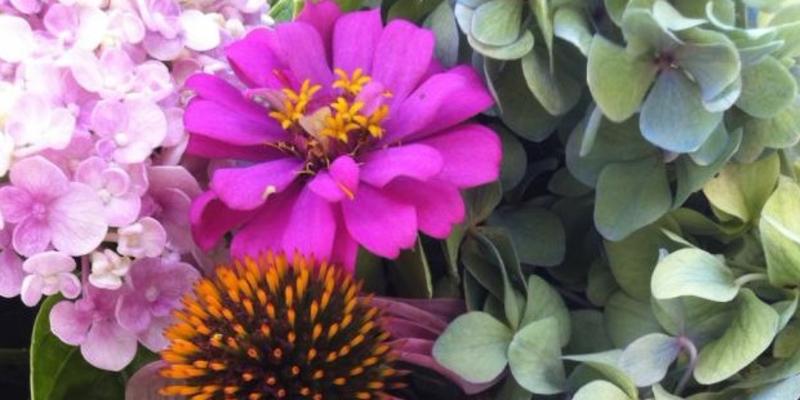
As some of the summer hydrangea blooms fade, I have started to consider fall additions for my hydrangea collection. Hydrangeas are easy to grow, beautiful in the landscape, and an excellent choice for both dried and fresh-cut floral displays. There are many varieties to choose from, with the bloom season extending from May through November.
BIG LEAF HYDRANGEA
One of the more popular varieties is the Hydrangea macrophylla. This 'big leaf hydrangea’ is native to Japan and includes our showy mopheads and the graceful lacecaps. One of my favorite Hydrangea macrophylla is called ‘Ayesha.’ Ayesha is unique with its long-lasting waxy blooms, and the texture of the bloom is different than most. The spoon-shaped sepals have an unusual texture similar to a succulent. They last longer than most in cut floral displays and are pH sensitive.
This pH sensitivity gives the gardener the option to push blooms from blue to purple to pink. The color is dictated by the soil acidity. The more acidic the soil, the more blue the hue. The more alkaline the soil, the more your bloom will fall into the red spectrum. A neutral soil can produce purple or the desirable half pink, half purple hydrangea. Stabilizing blue hues is easy just by making aluminum accessible in soil. You can purchase aluminum sulfate at your local garden center; just be sure to follow application recommendations on the bottle. If you prefer a more organic option, you can also add amendments to soil that will increase acidity such as coffee grounds and grass clippings.

‘Ayesha’; photo by Vintage Garden
GENERAL GROWING NOTES:

Close-up of Hydrangea macrophylla ‘Ayesha’ (upper left) in bouquet (all elements taken from my front yard!)
Other players in bouquet are:
OAKLEAF HYDRANGEA
Another hydrangea that is a great option for a Lowcountry garden is the native Oakleaf hydrangea, Hydrangea quercifolia, first discovered in the early 19th century. The Oakleaf hydrangea gets its name from the shape of its leaves and offers visual interest through multiple seasons. It blooms May through July and has dramatic pyramidal clusters of white flowers that attract butterflies. After the blooms have gone, this hydrangea’s show is not over. In comes a vivid display of autumnal foliage, with rich hues ranging from golden browns to deep cinnabar. It's a large shrub so give it plenty of room. You can also use a sunny location, versus with the macrophylla, which prefers some shade.

Oakleaf hydrangea; photo by Vintage Garden
GENERAL GROWING NOTES:
Find more information here:
DIY PROJECT: Add Color to Dried Hydrangeas
Every year, I dry my hydrangeas. They are absolutely beautiful, and I do not have to worry about watering them. I place them in vases, use them to make wreaths, and even brighten up the dark summer fireplace that sits unused in our hot Charleston summer. Eventually they begin to look washed-out and not so bright and cheery. This DIY from Front Yard to Table is an easy fix to refresh those worn-out hydrangeas.

Hydrangeas before

Hydrangeas after
Supplies Needed:
For blue hydrangeas: French Blue 747, Blueberry 682, Blue Sky 751
For green hydrangeas: Basil 676, Olive Green Bright 790, Aspen Yellow 791
Step 1
Gather supplies and cover work surface with paper to protect from overspray. Place the dried hydrangea bloom on covered work surface.

Step 2
Apply base coat: Spray a base coat over entire bloom. If you are working in the green palette you will start with Basil 676. If you are working with a blue palette you will use Blueberry 682.

Step 3
Add color depth: Spray the next color unevenly over base coat. This will give your bloom a mottled appearance that looks similar to nature. Green palette use Olive Bright 790; blue palette use French Blue 682.

Step 4
Apply highlights: Spray 2 to 3 small areas with lightest color to spot highlight. This will create a third layer of color. The less uniform the better. The third color strengthens the depth of color as one would find in nature. Green palette use Aspen Yellow 791; blue palette use Blue Sky 751.

Step 5
Admire your work: You now have your colorful hydrangeas back to enjoy once again!
